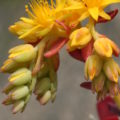During one of my several visits to our new home before we moved, the previous owner offered to leave us some things that wouldn’t fit into her new apartment, including a two-meter tall Yucca plant. I didn’t really care for its looks, but what the heck – it was certainly thriving. When it actually came time to move, she told me that this plant had been taken away by her (soon-to-be-ex) husband as it actually belonged to his mother, but she had a smaller version that she would leave me instead. The smaller one, only about three feet tall, was sitting in the front yard in a pot. I noticed that the neighbors also had one, planted in their yard.
Then we found out that these neighbors, too, are separating and on the road to divorce. “La chiamano la pianta della felicita’, ma dicono che porta sfiga,” remarked Enrico. [“It’s called the plant of happiness, but they say it brings bad luck.”] Given the plant’s track record – 50% of the couples in this small complex divorcing! – we decided not to take any chances. I thought a ritual dismemberment or burning of the plant would be appropriate, but Enrico felt that would be going too far. So one day he took the plant out in the car and left it in front of someone’s house in a nearby town (thereby leaving the bad luck with them, we assume!).
The following week, two friends of ours died in completely unrelated incidents in different parts of Italy (one in a car accident, one of aneurysm). We concluded that we had either got rid of the plant just in time, or had not got rid of it fast enough. I still think we should have burned it.
Dec, 2004
Mike Richter says: “The yucca has an attribute you overlooked. Those ummm ‘startling’ spines are the ‘cactus needles’ some used to play 78s back in ancient times. I had a three-meter yucca beside my front porch (until it threatened to replace the porch) and still have some of its needles in my Grafonola. I hasten to add that they are not used in place of steel or plastic ones; they tend to leave resin behind in the groove.”



